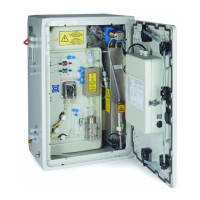Page 94
18. Cal Signal (if configured in the system). Use this function to test the Calibration Signal output. To
change the state of the device, press the ENTER key, set the device to ON/OFF, and press the ENTER
key again. If the device is on, it will be marked with an “*”. See Section 8.3.5 Output Devices for details.
19. Maint Signal (if configured in the system). Use this function to test the Maintenance Signal output. To
change the state of the device, press the ENTER key, set the device to ON/OFF, and press the ENTER
key again. If the device is on, it will be marked with an “*”. See Section 8.3.5 Output Devices for details.
20. Remote Standby (if configured in the system). Use this function to test the Remote Standby output. To
change the state of the device, press the ENTER key, set the device to ON/OFF, and press the ENTER
key again. If the device is on, it will be marked with an “*”. See Section 8.3.5 Output Devices for details.
21. Stop (if configured in the system). Use this function to test the Stop output. To change the state of the
device, press the ENTER key, set the device to ON/OFF, and press the ENTER key again. If the device is
on, it will be marked with an “*”. See Section 8.3.5 Output Devices for details.
22. Note (if configured in the system). Use this function to test the system Notification output. To change
the state of the device, press the ENTER key, set the device to ON/OFF, and press the ENTER key
again. If the device is on, it will be marked with an “*”. See Section 8.3.5 Output Devices for details.
23. Warning (if configured in the system). Use these functions to test the Warning output. To change the
state of the device, press the ENTER key, set the device to ON/OFF, and press the ENTER key again. If
the device is on, it will be marked with an “*”. See Section 8.3.5 Output Devices for details.
24. Fault (if configured in the system). Use this function to test the Fault output. To change the state of the
device, press the ENTER key, set the device to ON/OFF, and press the ENTER key again. If the device is
on, it will be marked with an “*”. See Section 8.3.5 Output Devices for details.
25. Man Mode Trig (if configured in the system). Use this function to test system Manual Mode Trigger
output. To change the state of the device, press the ENTER key, set the device to ON/OFF, and press
the ENTER key again. If the device is on, it will be marked with an “*”. See Section 8.3.5 Output
Devices for details.
26. 4-20mA Chng (if configured in the system). Use this function to test system generic 4-20mA Change
output signal. To change the state of the device, press the ENTER key, set the device to ON/OFF, and
press the ENTER key again. If the device is on, it will be marked with an “*”. See Section 8.3.5
Output Devices for details.
27-29. 4-20mA Chng 1-3 (if configured in the system). Use this function to test system 4-20mA Change
output signal for stream specific channels from Channel 1 to Channel 3. To change the state of the
device, press the ENTER key, set the device to ON/OFF, and press the ENTER key again. If the device is
on, it will be marked with an “*”. See Section 8.3.5 Output Devices for details.
30. 4-20mA Read (if configured in the system). Use this function to test system 4-20mA Read output. To
change the state of the device, press the ENTER key, set the device to ON/OFF, and press the ENTER
key again. If the device is on, it will be marked with an “*”.See Section 8.3.5 Output Devices for details.
32. Input/Output Status. Input/Output Status is a link to Maintenance, Diagnostics, Input/Output Status
menu (see Section 8.1.5 Input/Output Status for details).

